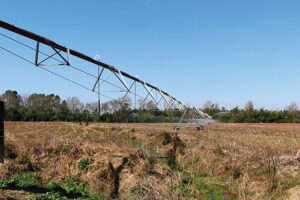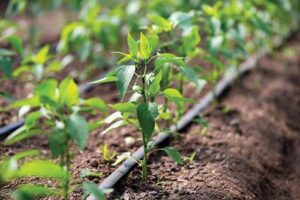
Research has found fertigating crops can improve efficiency of fertilizer use, but manually calculating numbers or using spreadsheets to determine fertilizer amounts needed can be time-consuming.
To help ease this burden, Clemson University researchers — Justin Ballew; Kendall Kirk, PhD; Rob Last and Zack Snipes — developed easy-to-use web-based calculators (apps) to help farmers set up fertigation plans. These free apps can be used on any device with a web browser.
These free apps can be used on any device with a web browser.
Fertigation is the process of running fertilizers through irrigation systems so that crops simultaneously receive nutrients and water. The researchers worked with members of the South Carolina farming community to create apps to help producers make more precise fertilizer applications, which can save money, increase crop productivity and reduce environmental impact.

The Clemson Center Pivot Fertigation Calculator is one of the apps farmers can use to calculate the flow rate of liquid fertilizer and injection pump settings needed to fertigate through a center pivot irrigation system.
“We developed this calculator for center pivot fertigation after a producer called and wanted instructions on how to set up his fertigation system,” Kirk says. “We realized a lot of calculations are involved when growers fertigate, and we could make people’s lives a lot easier if we could give them a system that could calculate some of these things for them.”
To use the app, producers input information including fertilizer formulation, pivot size, pivot travel time, fertilizer rate and injection pump manufacturer/ model. The calculator then determines liquid fertilizer flow rate required to supply the needed nutrients, as well as rate per acre of each fertilizer component and recommended injection pump setting.
“We realized a lot of calculations are involved when growers fertigate, and we could make people’s lives a lot easier if we could give them a system that could calculate some of these things for them.” – Kendall Kirk, PhD
The calculator also creates fertigation schedules. Results and direct links to the inputs can be sent directly to the producer’s email address.
Ben Fogle, a core technician who uses the app, says this calculator is convenient in that it can be used anywhere internet is available.
“Producers can pull out their cell phones and use the fertigation calculation app when they are in the field,” Fogle says. “As long as internet is available, this app can be used.”
Jacob Oswald works with growers across South Carolina to determine how to maximize yields while maintaining an efficient economic investment in their farming operations.
“I find this calculator particularly useful because calculating correct application rates for nutrients injected through irrigation systems can be a difficult process,” Oswald says. “A lot of times, the information required comes from multiple sources. This calculator has taken all of these variables and research and combined them into one user-friendly platform.”
Another tool is the Clemson Drip Fertigation Calculator, developed to help vegetable growers achieve the greatest returns on investments while protecting the environment when fertigating through drip irrigation systems.
“By adding liquid fertilizer to irrigation systems, plants are given a little bit of fertilizer each time farmers water their crops,” Snipes says. “This reduces nutrient loss from runoff and leaching as compared to granular applications.”
To use the Clemson Drip Fertigation Calculator, growers select the fertilizer formulation to be used, pounds of nitrogen needed per acre per day and the amount of acreage to be fertigated. The calculator determines how many gallons of fertilizer are required to supply needed nutrients through a drip irrigation system. A drop-down menu allows users to input the age of a crop to help determine crop nutrient demands at that stage of development.
The calculator determines how many gallons of fertilizer are required to supply needed nutrients through a drip irrigation system.
Recommendations are cross-referenced from the Southeastern U.S. Vegetable Crop Handbook and the North Carolina Strawberry Association’s Strawberry Plasticulture Guide. Using the app helps reduce risks associated with calculation error in fertilizer applications.
“Most clients ask for information on application rates of the products, some to make cost comparisons, others to look at refining their fertigation regime,” Last says. “Another question I regularly get from clients involves nutrient delivery — amount of nutrients — required for the crop’s specific growth and development. Take watermelons for example. Nutrient recommendations vary depending on if the crop is producing fruit.”
Jim Basara, coordinator of a 6-acre community farm on Spring Island, says this app helps make his job easier.
“Rather than calculating by hand or building a spreadsheet, everything I need is in an easy-to-use package,” Basara says. “I can very quickly and easily go through the requirements for each crop or group of crops that I want to feed the same way.”

After producers started using the apps, questions began to come in about custom liquid solutions. The researchers developed the Liquid Fertilizer Solution Calculator to help producers calculate nutrient compositions when mixing their own liquid solutions from soluble fertilizers. To use the Liquid Fertilizer Solution Calculator, producers define a starting water volume and then select up to three water-soluble fertilizers for calculation of their solution.
“Several nominal fertilizers are built into the calculator from which to select, or producers can use custom fertilizers that aren’t on the list by inputting nutrient compositions (N, P, K and micronutrients) from the labels,” Kirk says. “Producers input weights of each fertilizer added to the solution and the calculator does the rest, outputting the final formulation, density and volume of the liquid solution.”
For many fertilizers on the nominal list, the calculator even has maximum solubility data factored in, which warns users if the concentration they’re trying to use exceeds the maximum solubility of the product.
“Everything is calculated in real time, so tweaking the recipe is as easy as changing a value,” Kirk says.
To determine nutrient composition, Kirk says users must generally just know the target volume for the batch they’re mixing and the nutrient composition of the soluble fertilizer they’re using, which will be marked on the label.
“Users should be aware that the final solution volume will exceed the starting water volume,” he says. “Optionally, users also may input loose bulk density for their soluble fertilizers, and the calculator will not only show them the weight of fertilizer to add to the solution but also the volume, for example, in cups or quarts. This is handy for when a scale is not available.”
Bulk densities are already built in for almost all of the nominal fertilizers. The outputs can feed directly into the pivot fertigation calculator and the drip fertigation calculator.
“Having an option to make their own liquid concentrate recipes gives producers and growers some flexibility,” Ballew says. “Even if not limited in selection, cost per unit nutrient mass is generally more than double when purchasing liquid concentrates, as compared to purchasing soluble fertilizers.”
These calculators and additional web apps can be found at .
8280 Willow Oaks Corporate Drive | Suite 630 | Fairfax, VA 22031
Tel: 703.536.7080 | Fax: 703.536.7019
HOME | ABOUT US | ADVERTISE | SUBSCRIBE | CONTACT | PRIVACY POLICY | IA ANTITRUST STATEMENT